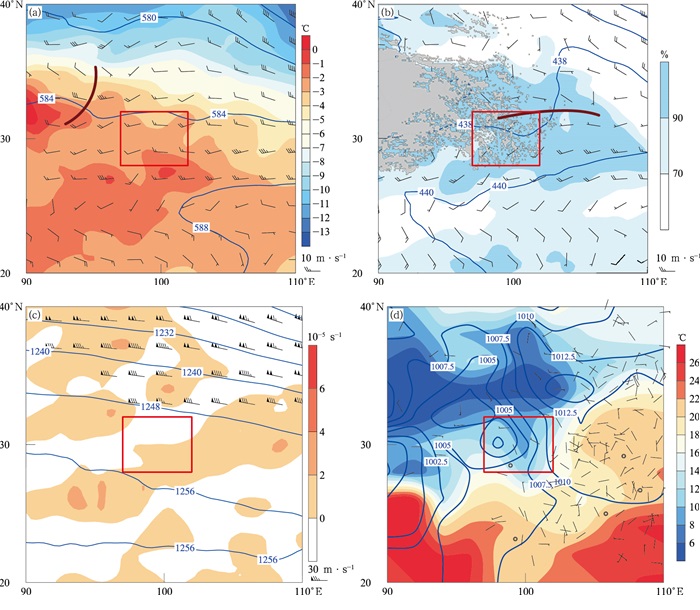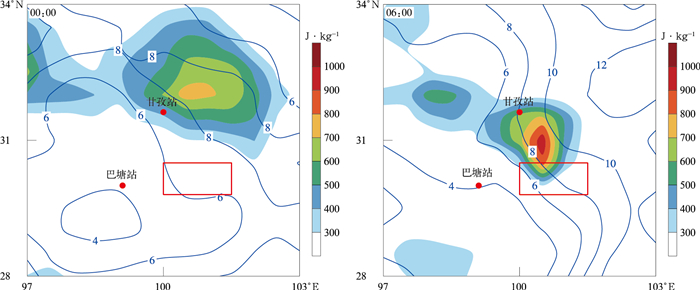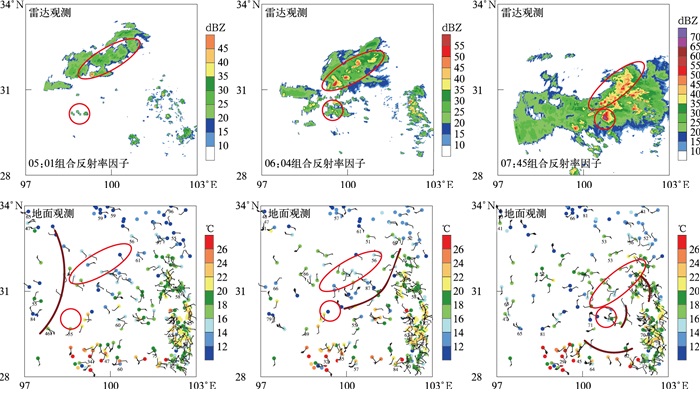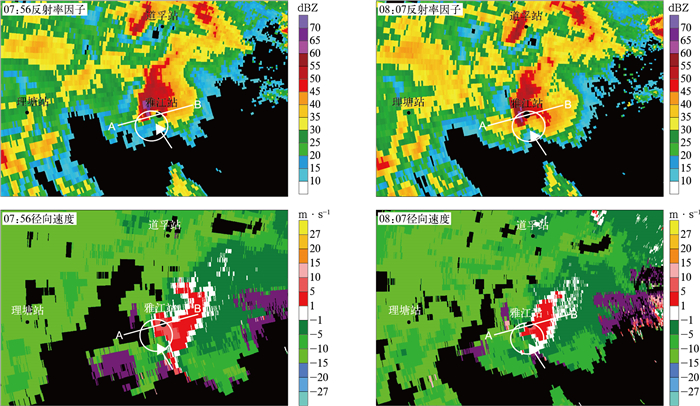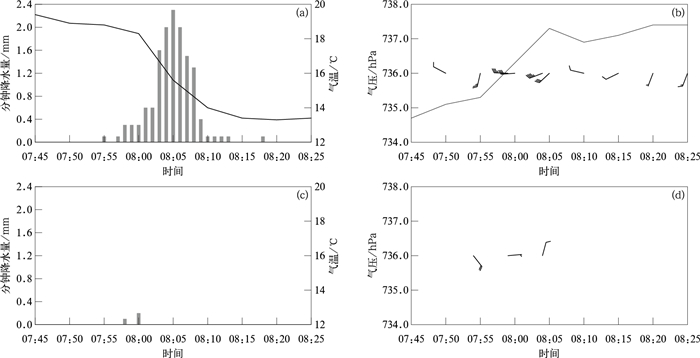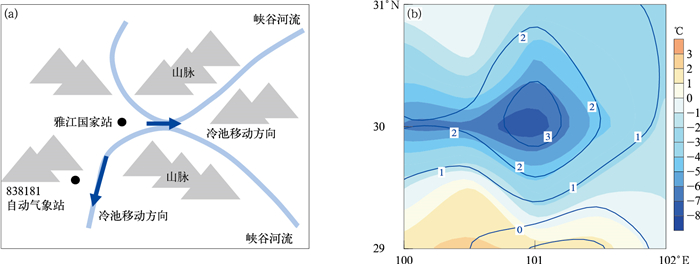Observational Characteristics of A Hybrid Severe Convective Event in the Sichuan-Tibet Region
-
摘要: 利用中国气象局地面自动气象站、探空、天气雷达等观测资料和ERA-Interim再分析资料,分析2016年9月8日川藏高原一次强对流天气过程。结果表明:该过程多站出现8级雷暴大风、10 mm以上小时强降水且伴有最大直径为18 mm的冰雹,是川藏高原一次混合型强对流过程。对流系统发生在500 hPa弱冷平流和低层切变线影响下,中低层深厚湿层、环境中等强度对流有效位能和垂直风切变为超级单体的形成和维持提供有利条件。初始北侧多单体和南侧弱对流在地面辐合线上生成,向东南移入适宜环境后,北侧多单体发展成线状对流系统,与南侧单体合并且促使其迅速发展成超级单体。成熟超级单体低层具有清晰的前侧入流缺口、钩状回波和中气旋特征。强回波区随高度前倾,呈显著的上冲云顶突起、回波悬垂和有界弱回波区。风暴内中层径向辐合、上升气流减弱和反射率因子核心快速下降预示下击暴流的产生。中层干空气的夹卷和水凝物快速下落的拖曳作用加强下沉气流,结合峡谷地形的狭管效应,引起地面大风。Abstract: The Sichuan-Tibet Region is a key area for the development of western China, where severe convective weather such as thunderstorm gales occur frequently. However, due to the complex terrains, synoptic systems, and the lack of meteorological observations, it is especially challenging to make accurate prediction. To better understand the mechanism of severe convective weather over the plateau, a rare severe convective event in the Sichuan-Tibet Region on 8 Sep 2016 is analyzed with weather reports, hourly and minutely surface observations, sounding data and Doppler weather radar data from China Meteorological Administration and ERA-Interim 0.5°×0.5° reanalysis data from European Centre for Medium-Range Weather Forecasts (ECMWF). The result shows that hourly rainfall of over 10 mm and hails of over 18 mm are observed at several weather stations, indicating a hybrid moist convective event. The meso-scale convective system (MCS) occurs near a shear line at low level with weak cold advection at 500 hPa. Large environmental convective available potential energy (CAPE), vertical wind shear, and the thick moist atmospheric layer are conductive to the formation of supercell. The initial convection is generated along a surface convergence line, with multiple γ meso-scale cells embedded in stratiform cloud in the north and cluster cells in the south. They move to the southeast, enter the favorable environment and merge with each other, enabling the cell on the south side to quickly develop into a supercell. When the supercell grows matured, the characteristic of front inflow gap, hook echoes and mesoscale cyclone at low levels are clear. The strong echo region tilts forward with height. There is significant overshooting top with the echo top height up to 15 km above ground in the upper troposphere, and obvious echo overhang capping bounded weak-echo region (BWER) in the middle layer. Mid-altitude radial convergence, weakening of updrafts and rapid drop of the reflectivity core indicate the occurrence of downbursts inside the storm. The cooling effect due to the entrainment of midlevel dry air is favorable to the growing of big hails and raindrops, and the formation of downdrafts. Moreover, the drag effect related to the rapid drop of heavy raindrops and hails, and the narrow tube effect of the canyon terrain, contribute to the formation of thunderstorm gales near the ground.
-
Key words:
- the Sichuan-Tibet Region;
- thunderstorm gales;
- supercell
-
图 1 2016年9月8日05:00—09:00南侧和北侧强对流中心移动路径
(时间间隔为30 min,黑色和红色线段分别为雷达最大组合反射率因子在35~60 dBZ和不小于60 dBZ)(a)及2010—2017年青藏高原地区冰雹直径的概率分布(b)
Fig. 1 Moving paths of strong convection centers(the time interval is 30 min, the black and red lines denote the reflectivity factor ranging from 35-60 dBZ and more than 60 dBZ) from 0500 UTC to 0900 UTC on 8 Sep 2016(a) and probability distribution of hail diameter in the Qinghai-Tibet Region during 2010-2017(b)
图 2 2016年9月8日00:00高度场(等值线,单位:dagpm)和风场
(红色方框为发生对流区域)
(a)500 hPa(填色为温度,棕色实线为槽线),(b)600 hPa(填色为相对湿度,棕色实线为切变线,灰色为地形),(c)200 hPa(风羽指示大于等于30 m·s-1高空急流区,填色为散度),(d)地面(蓝色等值线为海平面气压,单位:hPa;填色为温度)Fig. 2 Geopotential height(the contour, unit:dagpm) and wind at 0000 UTC on 8 Sep 2016
(the red rectangle denotes convection area)
(a)500 hPa(the shaded denotes temperature, the brown curve denotes trough), (b)600 hPa(the shaded denotes relative humidity, the brown curve denotes shear line, the grey denotes terrain), (c)200 hPa(the barb denotes upper level jet stream with wind velocity no less than 30 m·s-1, the shaded denotes divergence), (d)surface(the contour denotes sea-level pressure, unit:hPa;the shaded denotes temperature)图 4 2016年9月8日甘孜站雷达观测和地面观测
(圆点为气温,数字为相对湿度(单位:%),棕色实线为地面辐合线,红色椭圆分别指示南、北侧对流位置)
Fig. 4 Radar and surface observations at Ganzi on 8 Sep 2016
(the dot denotes surface temperature, the number denotes relative humidity(unit:%), the brown curve denotes surface convergence lines, the red ellipse denotes convection positions)
图 5 2016年9月8日07:45甘孜雷达0.5°仰角观测
(a)反射率因子(白色圆指示勾状回波,白色箭头指示前侧(B侧)入流缺口),(b)沿图 5a中AB的垂直剖面(白色椭圆指示回波悬垂区域),(c)径向速度(白色椭圆指示中气旋区域),(d)沿图 5c中AB的垂直剖面(白色椭圆指示中层径向辐合区域,白色箭头指示风暴内气流的方向)
Fig. 5 Observation at 0.5°elevation angle by Ganzi radar on 8 Sep 2016
(a)reflectivity factors(the white ellipse denotes hook echo, the white arrow indicates inflow gap), (b)vertical cross-section along line AB in Fig. 5a(the white ellipse denotes echo overhang), (c)reflectivity factors(the white ellipse denotes mesocyclone), (d)vertical cross-section along line AB in Fig. 5c(the white arrow denotes storm inflow direction)
图 8 2016年9月8日07:45—08:25地面气象站要素时间演变
(a)雅江站分钟降水量(柱状)和逐5 min气温(曲线),(b)雅江站逐5 min气压(曲线)和风(风羽),(c)838181自动气象站分钟降水量,(d)838181自动气象站极大风矢量
Fig. 8 Surface meteorological elements evolution from 0745 UTC to 0825 UTC on 8 Sep 2016
(a)precipitation(the column) and temperature(the curve) at Yajiang station, (b)pressure(the curve) and wind(the barb)at Yajiang Station, (c)precipitation(the column) at auto weather station 838181, (d)hourly extreme wind(the barb) at auto weather station 838181
-
[1] 段亚鹏, 王东海, 刘英."东方之星"翻沉事件强对流天气分析及数值模拟.应用气象学报, 2017, 28(6):666-677. doi: 10.11898/1001-7313.20170603Duan Y P, Wang D H, Liu Y. Radar analysis and numerical simulation of strong convective weather for "Oriental Star" depression. Journal of Applied Meteorological Science, 2017, 28(6): 666-677. doi: 10.11898/1001-7313.20170603 [2] 宋连春. 中国气象灾害年鉴. 北京: 气象出版社, 2017.Song L C. China Meteorological Disaster Yearbook. Beijing: China Meteorological Press, 2017. [3] 俞小鼎, 张爱民, 郑媛媛, 等. 一次系列下击暴流事件的多普勒天气雷达分析. 应用气象学报, 2006, 17(4): 385-393. doi: 10.3969/j.issn.1001-7313.2006.04.001Yu X D, Zhang A M, Zheng Y Y, et al. Doppler radar analysis on a series of downburst events. Journal of Applied Meteorological Science, 2006, 17(4): 385-393. doi: 10.3969/j.issn.1001-7313.2006.04.001 [4] Wakimoto R M. The life cycle of thunderstorm gust fronts as viewed with Doppler radar and rawinsonde data. Monthly Weather Review, 1982, 110(8): 1060-1082. doi: 10.1175/1520-0493(1982)110<1060:TLCOTG>2.0.CO;2 [5] 张琳娜, 冉令坤, 李娜, 等. 雷暴大风过程中对流层中低层动量通量和动能通量输送特征研究. 大气科学, 2018, 42(1): 178-191. https://www.cnki.com.cn/Article/CJFDTOTAL-DQXK201801013.htmZhang L N, Ran L K, Li N, et al. Analysis of momentum flux and kinetic energy flux transport in the middle and lower troposphere during a thunderstorm event. Chinese Journal of Atmospheric Sciences, 2018, 42(1): 178-191. https://www.cnki.com.cn/Article/CJFDTOTAL-DQXK201801013.htm [6] 李国翠, 郭卫红, 王丽荣, 等. 阵风锋在短时大风预报中的应用. 气象, 2006, 32(8): 36-41. doi: 10.3969/j.issn.1000-0526.2006.08.006Li G C, Guo W H, Wang L R, et al. Application of gust front to damage wind forecasting. Meteorological Monthly, 2006, 32(8): 36-41. doi: 10.3969/j.issn.1000-0526.2006.08.006 [7] 吴芳芳, 王慧, 韦莹莹, 等. 一次强雷暴阵风锋和下击暴流的多普勒雷达特征. 气象, 2009, 35(1): 55-64. https://www.cnki.com.cn/Article/CJFDTOTAL-QXXX200901010.htmWu F F, Wang H, Wei Y Y, et al. Analysis of a strong gust front and downburst with Doppler weather radar data. Meteorological Monthly, 2009, 35(1): 55-64. https://www.cnki.com.cn/Article/CJFDTOTAL-QXXX200901010.htm [8] Bluestein H B. Severe Convective Storms and Tornadoes: Observations and Dynamics. Praxis/Springer, 2013: 120-153. http://link.springer.com/978-3-642-05381-8 [9] 郑永光, 周康辉, 盛杰, 等. 强对流天气监测预报预警技术进展. 应用气象学报, 2015, 26(6): 641-657. doi: 10.11898/1001-7313.20150601Zheng Y G, Zhou K H, Sheng J, et al. Advances in techniques of monitoring, forecasting and warning of severe convective weather. Journal of Applied Meteorological Science, 2015, 26(6): 641-657. doi: 10.11898/1001-7313.20150601 [10] Meng Z Y, Yan D C, Zhang Y J. General features of squall lines in East China. Monthly Weather Review, 2013, 141(5): 1629-1647. doi: 10.1175/MWR-D-12-00208.1 [11] Fujita T T. Tornadoes and downbursts in the context of generalized planetary scales. Journal of Atmospheric Sciences, 1981, 38(8): 1511-1534. doi: 10.1175/1520-0469(1981)038<1511:TADITC>2.0.CO;2 [12] 王福侠, 俞小鼎, 裴宇杰, 等. 河北省雷暴大风的雷达回波特征及预报关键点. 应用气象学报, 2016, 27(3): 342-351. doi: 10.11898/1001-7313.20160309Wang F X, Yu X D, Pei Y J, et al. Radar echo characteristics of thunderstorm gales and forecast key points in Hebei Province. Journal of Applied Meteorological Science, 2016, 27(3): 342-351. doi: 10.11898/1001-7313.20160309 [13] Schoen J M, Ashley W S. A climatology of fatal convective wind events by storm type. Weather and Forecasting, 2011, 26(1): 109-121. doi: 10.1175/2010WAF2222428.1 [14] Klimowski B A, Hjelmfelt M R, Bunkers M J. Radar observations of the early evolution of bow echoes. Weather and Forecasting, 2004, 19(4): 727-734. doi: 10.1175/1520-0434(2004)019<0727:ROOTEE>2.0.CO;2 [15] French A J, Parker M D. Numerical simulations of bow echo formation following a squall line-supercell merger. Monthly Weather Review, 2014, 142(12): 4791-4822. doi: 10.1175/MWR-D-13-00356.1 [16] French A J, Parker M D. Observations of mergers between squall lines and isolated supercell thunderstorms. Weather and Forecasting, 2012, 27(2): 255-278. doi: 10.1175/WAF-D-11-00058.1 [17] Schmidt J M, Cotton W R. A high plains squall line associated with severe surface winds. Journal of Atmospheric Sciences, 1989, 46(3): 281-302. doi: 10.1175/1520-0469(1989)046<0281:AHPSLA>2.0.CO;2 [18] 王秀明, 俞小鼎, 朱禾. NCEP再分析资料在强对流环境分析中的应用. 应用气象学报, 2012, 23(2): 139-146. doi: 10.3969/j.issn.1001-7313.2012.02.002Wang X M, Yu X D, Zhu H. The applicability of NCEP reanalysis data to severe convection environment analysis. Journal of Applied Meteorological Science, 2012, 23(2): 139-146. doi: 10.3969/j.issn.1001-7313.2012.02.002 [19] 马淑萍, 王秀明, 俞小鼎. 极端雷暴大风的环境参量特征. 应用气象学报, 2019, 30(3): 292-301. doi: 10.11898/1001-7313.20190304Ma S P, Wang X M, Yu X D. Environmental parameter characteristics of severe wind with extreme thunderstorm. Journal of Applied Meteorological Science, 2019, 30(3): 292-301. doi: 10.11898/1001-7313.20190304 [20] 王秀明, 周小刚, 俞小鼎. 雷暴大风环境特征及其对风暴结构影响的对比研究. 气象学报, 2013, 71(5): 839-852. https://www.cnki.com.cn/Article/CJFDTOTAL-QXXB201305004.htmWang X M, Zhou X G, Yu X D. Comparative study of environmental characteristics of a windstorm and their impacts on storm structures. Acta Meteorologica Sinica, 2013, 71(5): 839-852. https://www.cnki.com.cn/Article/CJFDTOTAL-QXXB201305004.htm [21] 陈淑琴, 章丽娜, 俞小鼎, 等. 浙北沿海连续3次飑线演变过程的环境条件. 应用气象学报, 2017, 28(3): 357-368. doi: 10.11898/1001-7313.20170309Chen S Q, Zhang L N, Yu X D, et al. Environmental conditions of three squall lines in the north part of Zhejiang Province. Journal of Applied Meteorological Science, 2017, 28(3): 357-368. doi: 10.11898/1001-7313.20170309 [22] 高晓梅, 俞小鼎, 王令军, 等. 山东半岛两次海风锋引起的强对流天气对比. 应用气象学报, 2018, 29(2): 245-256. doi: 10.11898/1001-7313.20180210Gao X M, Yu X D, Wang L J, et al. Comparative analysis of two strong convections triggered by sea-breeze front in Shandong Peninsula. Journal of Applied Meteorological Science, 2018, 29(2): 245-256. doi: 10.11898/1001-7313.20180210 [23] 孙继松, 戴建华, 何立富, 等. 强对流天气预报的基本原理与技术方法. 北京: 气象出版社, 2014.Sun J S, Dai J H, He L F, et al. The Principles and Techniques of Severe Convective Weather Forecasting. Beijing: China Meteorological Press, 2014. [24] 张鸿发, 郭三刚, 张义军, 等. 青藏高原强对流雷暴云分布特征. 高原气象, 2003, 22(6): 558-564. doi: 10.3321/j.issn:1000-0534.2003.06.005Zhang H F, Guo S G, Zhang Y J. Distribution characteristic of severe convective thunderstorm cloud over Qinghai-Xizang Plateau. Plateau Meteorology, 2003, 22(6): 558-564. doi: 10.3321/j.issn:1000-0534.2003.06.005 [25] 朱平, 俞小鼎. 青藏高原东北部一次罕见强对流天气的中小尺度系统特征分析. 高原气象, 2019, 38(1): 1-13. https://www.cnki.com.cn/Article/CJFDTOTAL-GYQX201901001.htmZhu P, Yu X D. Analysis of meso-small scale system characteristics of a rare severe convective weather in the northeast part of Qinghai-Tibetan Plateau. Plateau Meteorology, 2019, 38(1): 1-13. https://www.cnki.com.cn/Article/CJFDTOTAL-GYQX201901001.htm [26] Li J. Hourly station-based precipitation characteristics over the Tibetan Plateau. International Journal of Climatology, 2017, 38(1): 1560-1570. http://smartsearch.nstl.gov.cn/paper_detail.html?id=05dc5bcf4691c9ac999865bbe0a71ac7 [27] 王彬雁, 赵琳娜, 许晖, 等. 四川雨季小时降水的概率分布特征及其降水分区. 暴雨灾害, 2018, 37(2): 115-123. doi: 10.3969/j.issn.1004-9045.2018.02.003Wang B Y, Zhao L N, Xu H, et al. Probability distribution and partition of hourly rainfall during the rainy season over Sichuan Province. Torrential Rain and Disasters, 2018, 37(2): 115-123. doi: 10.3969/j.issn.1004-9045.2018.02.003 [28] Li X F, Zhang Q H, Zou T J, et al. Climatology of hail frequency and size in China, 1980-2015. Journal of Applied Meteorology and Climatology, 2018, 57(4): 875-887. doi: 10.1175/JAMC-D-17-0208.1 [29] 王黉, 李英, 宋丽莉, 等. 川藏地区雷暴大风活动特征和环境因子对比. 应用气象学报, 2020, 31(4): 435-446. doi: 10.11898/1001-7313.20200406Wang H, Li Y, Song L L, et al. Comparison of characteristics and environmental factors of thunderstorm gales over the Sichuan-Tibet Region. Journal of Applied Meteorological Science, 2020, 31(4): 435-446. doi: 10.11898/1001-7313.20200406 [30] Atkins N T, Wakimoto R M. Wet microburst activity over the southeastern United States: Implications for forecasting. Weather and Forecasting, 1991, 6(4): 470-482. doi: 10.1175/1520-0434(1991)006<0470:WMAOTS>2.0.CO;2 [31] Rickenbach T M, Rutledge S A. Convection in TOGA COARE: Horizontal scale, morphology, and rainfall production. Journal of Atmospheric Sciences, 1998, 55(17): 2715-2729. doi: 10.1175/1520-0469(1998)055<2715:CITCHS>2.0.CO;2 [32] Moller A R, Doswell Ⅲ C A, Foster M P, et al. The operational recognition of supercell thunderstorm environments and storm structures. Weather and Forecasting, 1994, 9(3): 327-347. doi: 10.1175/1520-0434(1994)009<0327:TOROST>2.0.CO;2 [33] Bluestein H B, Parks C R. A synoptic and photographic climatology of low-precipitation severe thunderstorms in the southern plains. Monthly Weather Review, 1983, 111(10): 2034-2046. doi: 10.1175/1520-0493(1983)111<2034:ASAPCO>2.0.CO;2 [34] Rasmussen E N, Straka J M. Variations in supercell morphology. Part Ⅰ: Observations of the role of upper-level storm-relative flow. Monthly Weather Review, 1998, 126(9): 2406-2421. doi: 10.1175/1520-0493(1998)126<2406:VISMPI>2.0.CO;2 [35] Roberts R D, Wilson J W. A proposed microburst nowcasting procedure using single-Doppler radar. Journal of Applied Meteorology and Climatology, 1989, 28(4): 285-303. doi: 10.1175/1520-0450(1989)028<0285:APMNPU>2.0.CO;2 [36] Doswell C A, Burgess D W. Tornadoes and Tornadic Storms: A Review of Conceptual Models. The Tornado: Its Structure, Dynamics, Prediction, and Hazards. Geophysical Monograph, American Geophysical Union, 1993: 161-172. doi: 10.1029/GM079 [37] Funk T W, Darmofal K E, Kirkpatrick J D, et al. Storm reflectivity and mesocyclone evolution associated with the 15 April 1994 squall line over Kentucky and Southern Indiana. Weather and Forecasting, 1999, 14(6): 976-993. doi: 10.1175/1520-0434(1999)014<0976:SRAMEA>2.0.CO;2 [38] Markowski P M, Richardson Y P. Mesoscale Meteorology in Midlatitudes. Chichester: Wiley-Blackwell, 2010: 245-260. -


 设为首页
设为首页 加入收藏
加入收藏


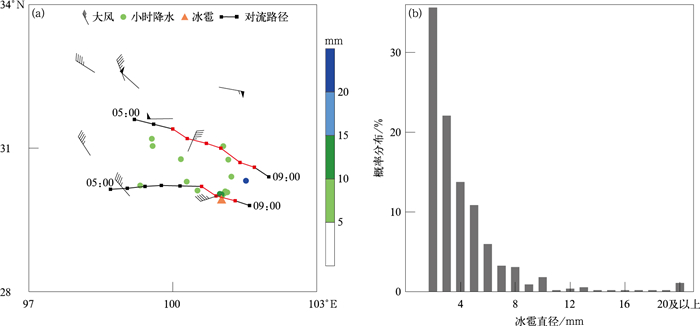
 下载:
下载:
